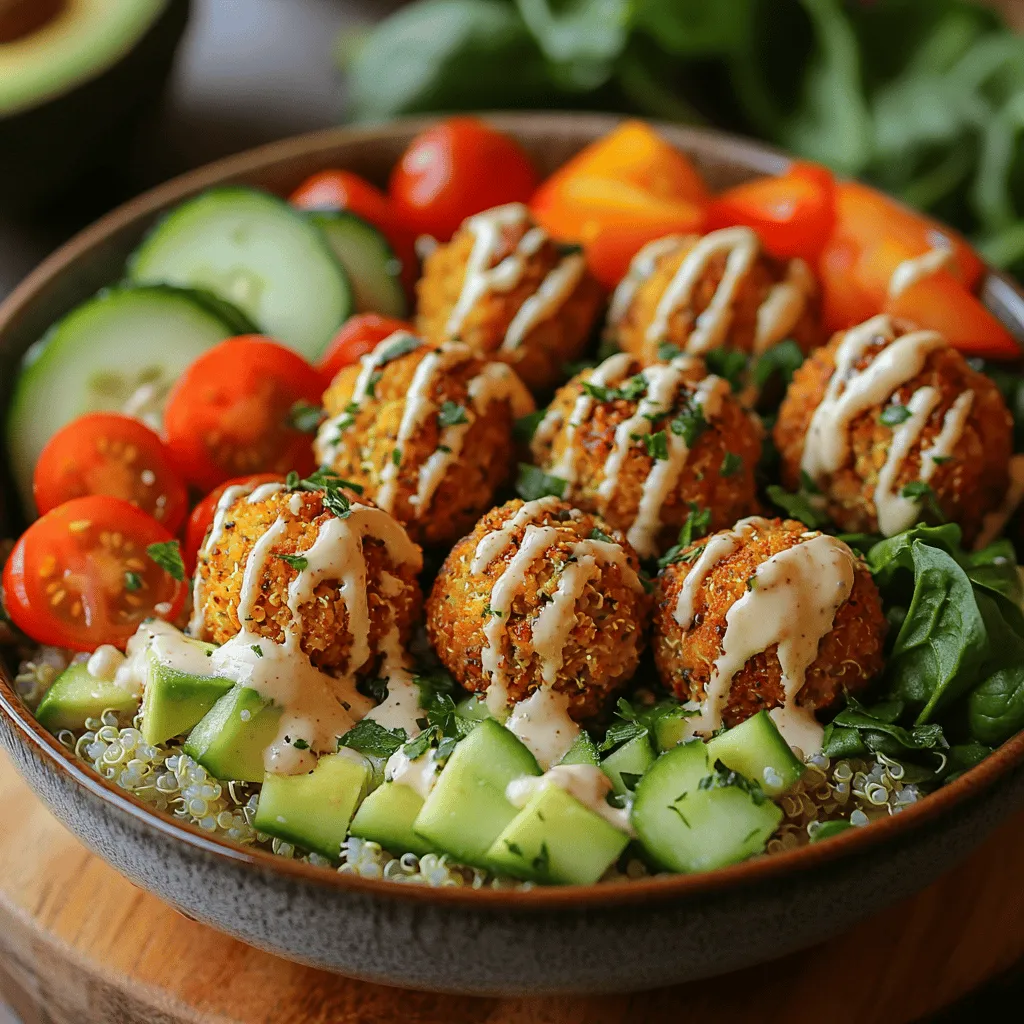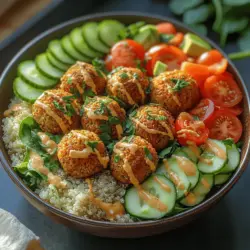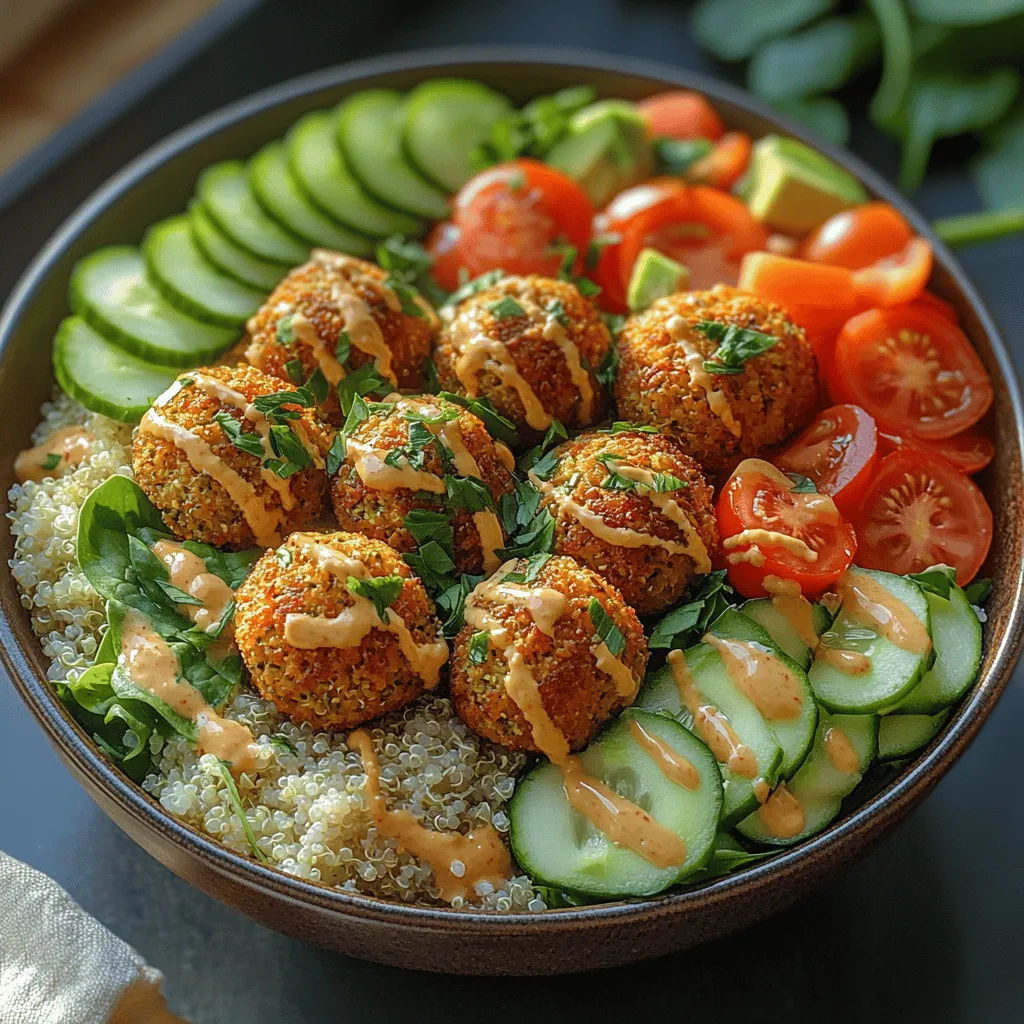Introduction
In today’s health-conscious world, finding meals that are both nutritious and satisfying can feel like a daunting task. Enter Baked Falafel Power Bowls: a colorful and nutrient-dense option that not only pleases the palate but also aligns perfectly with modern dietary preferences. These bowls are an ideal solution for anyone seeking a balance of flavor and health, combining the rich textures of baked falafel with an array of fresh vegetables and grains. Whether you’re a busy professional navigating a hectic schedule or a parent searching for a wholesome meal that the whole family will enjoy, this recipe is designed to be both convenient and delicious.
As we delve into the preparation of Baked Falafel Power Bowls, we’ll explore the origins of falafel, the nutritional benefits of its primary ingredient—chickpeas—as well as the vibrant components that make up the dish. By understanding the background and the health advantages of these ingredients, you can appreciate the value of this meal not just as a recipe, but as a nourishing experience.
Understanding Falafel: A Brief History
Falafel has a rich and storied history that dates back centuries. Originally believed to have originated in the Middle East, this delightful dish is often associated with Egyptian cuisine, where it was made from fava beans. Over time, falafel made its way across the region, with chickpeas becoming a popular substitute, particularly in Levantine countries like Lebanon, Syria, and Palestine. Today, falafel is a staple in Middle Eastern cuisine, often served in pita bread or alongside salads, and is celebrated for its crispy exterior and savory interior.
Culturally, falafel holds significant importance in Middle Eastern societies. It is not just a food item; it represents community, tradition, and shared meals. The dish has transcended its regional roots and has found a place in global culinary practices. In recent years, falafel has gained immense popularity among vegetarians, vegans, and health enthusiasts around the world, leading to various adaptations that cater to different tastes and dietary restrictions. From gourmet falafel burgers to fusion dishes, its versatility has made it a beloved ingredient in many kitchens.
Nutritional Benefits of Chickpeas
At the heart of falafel lies the humble chickpea, a legume that boasts an impressive nutritional profile. Chickpeas are an excellent source of plant-based protein, making them a perfect choice for vegetarians and vegans who are looking to meet their protein needs. Just one cup of cooked chickpeas contains approximately 15 grams of protein, which is essential for muscle repair and overall bodily functions.
In addition to their protein content, chickpeas are rich in dietary fiber, which plays a crucial role in promoting digestive health. Fiber aids in maintaining a healthy gut, regulating blood sugar levels, and keeping you feeling full, which can be beneficial for weight management. Furthermore, chickpeas are packed with essential vitamins and minerals, including folate, iron, magnesium, and zinc, all of which contribute to overall health and well-being.
With their impressive nutrient density, chickpeas serve as a foundational ingredient in Baked Falafel Power Bowls, ensuring that each bite not only satisfies your taste buds but also nourishes your body.
The Ingredients Breakdown
To create the perfect Baked Falafel Power Bowls, it’s essential to understand the key ingredients that contribute to both flavor and nutrition.
First and foremost are the chickpeas, which form the base of the falafel. They can be used either dried and soaked or canned for convenience. When opting for canned chickpeas, be sure to rinse and drain them well to remove excess sodium.
Herbs play a pivotal role in elevating the flavor profile of falafel. Fresh parsley and cilantro are commonly used, providing a burst of freshness that complements the earthiness of the chickpeas. Not only do these herbs add flavor, but they also come with their own set of health benefits, including antioxidants and vitamins.
Spices are another crucial component of the falafel mixture. Cumin and coriander are traditional spices that lend depth and warmth to the dish. Cumin is known for its rich, nutty flavor and digestive benefits, while coriander adds a bright, citrusy note that balances the earthiness of the chickpeas.
Finally, the choice of grains served in the power bowl can greatly affect the overall texture and heartiness of the meal. Both quinoa and brown rice are excellent options, providing additional protein, fiber, and essential nutrients. Quinoa, in particular, is a complete protein, meaning it contains all nine essential amino acids, making it a fantastic choice for plant-based diets.
Preparing the Baked Falafel
Now that we’ve explored the components of the Baked Falafel Power Bowls, it’s time to dive into the preparation of the falafel itself. The first step is to create the falafel mixture. If you’re using dried chickpeas, soak them in water overnight, allowing them to swell and soften. This step is crucial; canned chickpeas will not yield the same texture and flavor.
In a food processor, combine the soaked chickpeas with fresh herbs, spices, garlic, onion, and a touch of flour to bind the mixture. Pulse until you achieve your desired consistency—some prefer a chunkier texture for added bite, while others opt for a smoother blend. The key is to avoid over-processing, which can lead to a paste-like consistency rather than the ideal falafel texture.
Once your mixture is ready, form small balls or patties, and place them on a baking sheet lined with parchment paper. Lightly brush or spray them with olive oil to promote browning during baking. Preheat your oven to a suitable temperature—typically around 400°F (200°C)—and bake the falafel until they are golden brown and crispy, flipping them halfway through to ensure even cooking.
The process of making Baked Falafel is not only straightforward but also allows for creativity and personalization. Feel free to experiment with other herbs and spices that suit your taste preferences. The result will be a batch of flavorful, baked falafel that serves as the star ingredient in your power bowls.
As you prepare the falafel, your kitchen will fill with enticing aromas, setting the stage for a delightful meal that is both nourishing and satisfying.

The Science Behind Baking vs. Frying Falafel
When it comes to falafel, the traditional method often involves frying, which can lead to a heavy, greasy texture. However, baking falafel offers numerous advantages without sacrificing flavor. Baking is a healthier alternative that significantly reduces the amount of oil used, which decreases the overall fat content and calorie count. This method also allows for a crispy exterior while keeping the inside moist and flavorful.
Baking falafel also presents a more consistent texture, as each ball can achieve even cooking throughout. This is particularly beneficial for those who prefer a healthier lifestyle, as it aligns with the principles of reducing unnecessary fats while maintaining the dish’s signature taste. By opting for baked falafel, you not only create a guilt-free indulgence but also showcase the vibrant flavors of the herbs and spices incorporated into the mixture.
Assembling Your Power Bowl
Choosing the Right Base: Quinoa or Brown Rice
The foundation of any power bowl is the base, and both quinoa and brown rice are excellent choices. Quinoa, often referred to as a superfood, is a complete protein, meaning it contains all nine essential amino acids. It is also gluten-free and packed with fiber, which aids in digestion and keeps you feeling full longer.
On the other hand, brown rice offers a hearty texture and is rich in B vitamins, iron, and magnesium. It has a slightly nutty flavor that complements the spices in falafel beautifully. Choosing between quinoa and brown rice ultimately depends on your dietary preferences and nutritional needs. For a lighter option, go with quinoa; for a more filling base, brown rice is the way to go.
Layering Flavors: Incorporating Fresh Vegetables
Once you’ve selected your base, it’s time to layer in fresh vegetables to enhance the flavor and nutrition of your baked falafel power bowl. Fresh vegetables not only add color and texture but also provide essential vitamins and minerals. Consider using:
– Spinach or Kale: These leafy greens are packed with iron and vitamins A, C, and K. They can be served fresh or lightly sautéed for added flavor.
– Cherry Tomatoes: Their sweetness complements the savory falafel and adds a juicy burst to each bite.
– Cucumbers: These refreshing veggies add crunch and hydration, balancing the dish perfectly.
– Bell Peppers: Available in various colors, bell peppers add sweetness and a vibrant visual appeal.
– Red Onion: Thinly sliced red onion introduces a sharpness that contrasts beautifully with the creamy dressing.
Feel free to mix and match based on seasonal availability or personal preference. The key is to create a colorful, textured bowl that excites the palate.
The Role of Healthy Fats: Avocado and Olive Oil
Healthy fats are essential for a well-balanced meal, and they play a crucial role in flavor and texture. Avocado is an excellent source of monounsaturated fats, which can help lower bad cholesterol levels and keep your heart healthy. Its creamy consistency adds richness to the bowl, making it even more satisfying.
Drizzling a high-quality olive oil over your assembled power bowl not only enhances the flavor but also provides additional health benefits. Olive oil is rich in antioxidants and anti-inflammatory properties, which contribute to overall well-being. The combination of avocado and olive oil will elevate your dish, providing a creamy and satisfying mouthfeel.
The Art of Dressing Your Bowl
Exploring Various Dressing Options: Tahini and Beyond
Dressing is what ties all the components of your power bowl together, adding moisture and flavor. Tahini, a paste made from ground sesame seeds, is a popular choice for falafel bowls due to its nutty flavor and creamy texture. A simple tahini dressing can be made by mixing tahini with lemon juice, garlic, water, and a pinch of salt to taste.
However, there are numerous dressing options you can explore:
– Lemon-Herb Vinaigrette: A light vinaigrette made with fresh herbs, olive oil, and lemon juice can brighten up your bowl.
– Yogurt Sauce: A yogurt-based dressing mixed with garlic, lemon, and dill adds a refreshing creaminess.
– Spicy Harissa Sauce: For those who enjoy a kick, a drizzle of harissa can spice things up while complementing the flavors of the falafel.
How Dressings Enhance Flavor and Nutrition
Dressing not only enhances the overall flavor profile of your bowl but also contributes to its nutritional value. A good dressing can provide additional vitamins and healthy fats, making your meal more balanced. Additionally, dressing can help to meld the different flavors of the ingredients together, creating a harmonious experience with each bite.
Homemade vs. Store-Bought Dressings: Benefits and Considerations
While store-bought dressings offer convenience, they often contain preservatives, added sugars, and unhealthy fats. Making your own dressing allows you to control the ingredients and customize flavors to your liking. Homemade dressings can be made in bulk and stored in the refrigerator, providing a fresh option whenever you prepare your power bowls.
When opting for store-bought dressings, look for options with clean ingredients and minimal additives. Reading labels can help you make informed choices that align with your health goals.
Serving Suggestions and Variations
Creating a Customizable Power Bowl Experience
One of the best aspects of baked falafel power bowls is their versatility. Each bowl can be tailored to individual tastes and dietary requirements, making them perfect for family meals or gatherings. Set up a “build-your-own” station with various bases, vegetables, proteins, and dressings, allowing everyone to create their perfect combination.
Incorporating Seasonal Vegetables for Variety
Take advantage of seasonal produce to keep your power bowls fresh and exciting. In the spring, consider adding asparagus or peas; summer might call for grilled zucchini and corn; fall could feature roasted sweet potatoes or Brussels sprouts; and winter is ideal for hearty root vegetables like carrots and beets. This approach not only enhances flavor but also supports local agriculture.
Adding Protein: Chickpeas, Grilled Chicken, or Tofu Options
While baked falafel serves as a great source of protein, adding extra protein can make your power bowls even more satisfying. Chickpeas are a natural choice, as they complement the falafel flavor and provide additional fiber. For those seeking a meatier option, grilled chicken or shrimp can be delicious alternatives. Vegetarians may enjoy adding marinated and grilled tofu or tempeh for a protein boost without meat.
The Health Benefits of a Plant-Based Diet
Exploring the Advantages of Plant-Based Eating
Incorporating more plant-based meals into your diet can lead to numerous health benefits. Studies have shown that a plant-based diet can lower the risk of chronic diseases, improve heart health, and support weight management. Additionally, plant-based diets tend to be high in fiber, which is beneficial for digestion and satiety.
How Baked Falafel Power Bowls Fit Into a Balanced Diet
Baked Falafel Power Bowls exemplify a balanced meal by combining whole grains, legumes, healthy fats, and a variety of vegetables. This combination ensures you’re getting a well-rounded intake of nutrients, including proteins, carbohydrates, vitamins, and minerals. The versatility of this dish allows for endless customization, catering to various dietary needs, making it an excellent choice for health-conscious individuals.
The Environmental Benefits of Choosing Plant-Based Meals
Beyond personal health, choosing plant-based meals contributes to environmental sustainability. Animal agriculture is a major contributor to greenhouse gas emissions, deforestation, and water usage. By incorporating more plant-based meals, you can lower your carbon footprint and promote a more sustainable food system. Baked Falafel Power Bowls serve as a delicious and eco-friendly option, allowing you to enjoy your meal while contributing positively to the planet.
Conclusion
Baked Falafel Power Bowls are not just a meal; they’re a celebration of flavors, nutrition, and ease of preparation. This article has provided a comprehensive look at how to create these delightful bowls filled with vibrant ingredients. Embracing this recipe allows you to nourish your body while enjoying a delicious and satisfying dish that can be tailored to your tastes. Whether served for lunch, dinner, or meal prep, these power bowls are a fantastic addition to any culinary repertoire. With endless variations and the ability to customize, you can enjoy a nutritious and flavorful meal that aligns with your health goals and supports a sustainable lifestyle. So gather your ingredients and start assembling your perfect baked falafel power bowl today!

